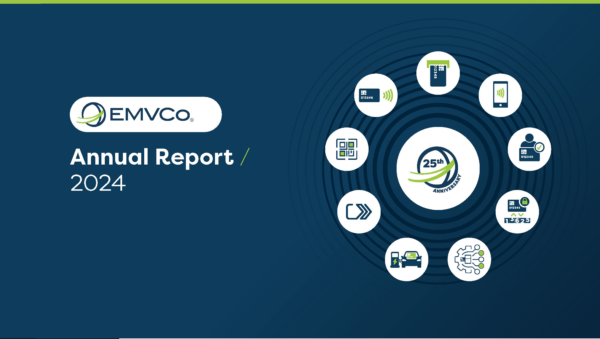In November, EMVCo Associates from around the globe met at the EMVCo Technical Meeting in Barcelona to engage in the technical direction of EMVCo and provide technical input to specification development activity. In this post, Arman Aygen, Director of Technology at EMVCo, highlights the key topics covered.
1. Moving forward with TapToMobile
EMVCo’s TapToMobile initiative – which aims to enable a good experience when consumer mobile devices are used for contactless payment acceptance – was a key area of focus and discussion throughout 2023.
EMVCo has been exploring the introduction of minimum acceptance criteria and a supporting approval process for TapToMobile – in addition to the existing process for traditional payment devices – that defines three levels of user experience with different requirements relating to read range and positioning as outlined within the EMV® Contactless Interface Specification. The introduction of two new Reduced Range Approvals will allow EMVCo, and industry participants, to start measuring the performance of these devices and provide feedback on how to improve their read range over time.
In Barcelona, EMVCo communicated that it is now refining the TapToMobile Level 1 Test Guidelines and Acceptance Criteria based on industry feedback and expects to publish these in early 2024.
2. Driving engagement on Electric Vehicle (EV) open payments
Following the launch of the Electric Vehicle Open Payments Task Force, discussions in Barcelona continued to centre on examining opportunities for integrating EMV Specifications with existing EV charging standards and protocols to support interoperable, open payments.
As part of this ongoing exploration, EMVCo reaffirmed its commitment to engagement in this initiative and welcomed interest and input on this topic from EV manufacturers, charge point operators, global standards bodies such as ISO, and industry groups such as CharIN and the Secure Technology Alliance.
3. Contactless payments as ‘mobility enablers’
Public transit authorities and operators across the globe are increasingly recognising the benefits of EMV Contactless technology as a ‘mobility enabler’, supporting seamless and secure payment experiences across mass public transit systems. Given this trend, EMVCo was pleased to welcome Llorenç Marcos Valls from Barcelona’s Metropolitan Transport Authority to discuss its planned launch of an EMV open loop system in 2024 to allow transit users to pay with their contactless card or mobile device.
EMVCo also provided an update on its work to support the use of mobile wallets for public transit. This includes an upcoming update to the EMV® Contactless Specifications for Payment Systems, Book B Entry Point Specification to add a new POI Information ID, ‘Transit Operator ID’. This will allow the terminal to indicate the particular transit operator it belongs to.
4. Enhancing and evolving EMV 3-D Secure (EMV 3DS) and Click to Pay
EMVCo explored potential specification and testing enhancements (with further deeper-dive discussion enabled by a dedicated Special Interest Meeting [SIM]). Associates were also updated on the publication of the EMV 3DS White Paper, which details how technical features can be implemented and integrated to address various business cases.
This was complemented by perspectives and learnings from EMVCo Associates. James Rendell from Broadcom presented an analysis on regional EMV 3DS authentication success rates, challenge rates and challenge success rates. Tanja Steinhoff at Netcetera, explored the ‘curb-cut effect’ and how designing challenge screens for people with permanent disabilities can improve accessibility and the customer experience (CX) for all.
In addition, EMVCo reported back on its research goals and plans following the conclusion of the public review of the EMV® Click to Pay CX Guidelines.
5. Supporting new ways to pay
EMVCo continues to engage with its Associates, Subscribers and industry partners to support emerging payment methods.
In 2022, EMVCo published the EMV Contactless Kernel Specification (EMV® Contactless Specifications for Payment Systems, Book C-8, Kernel 8 Specification) to support the evolution of contactless and mobile payments and simplify global acceptance. Following the publication, EMVCo has been working on the supporting approval process, which aims to reduce the development cycle, increase test efficiency and speed up testing with automation. Following extensive engagement with EMVCo Associates, EMVCo confirmed its plan to publish the testing process in early 2024.
In addition, and as part of EMVCo’s ongoing evaluation of the role wireless technologies can play in supporting in-store payment experiences, EMVCo confirmed the publication of its white paper – ‘Wireless Payment: Considerations for Use of EMV Chip’ – which explores the data and security considerations for wireless payments across multiple use-cases.
Finally, EMVCo continued to progress work to support the growing use of biometric payment cards. Discussion and engagement were complemented by a dedicated SIM on the Biometric on Card initiative to garner feedback from industry players, with contributions from Fime, cetecom advanced, Fingerprint Cards, IDEX Biometrics and Zwipe.
EMVCo’s next Technical Meeting will be in Phoenix, USA, in April. Want to be there and participate? Become an EMVCo Associate.



